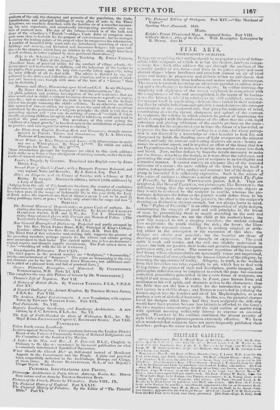FINE ARTS.
WESTMACOTT'S OUTLINES.
Fr appears surpri.‘in;:f that outline should be so popular a style of deline- ation, While sculpture. of which it is but the shadow, interests compa- ra:ively few : both alike addre:s the eye through the medium of the
essential quality of art, form—and form in its purest aspect and most elegant shape S where loveliness and grandeur assume an air of ideal grace and beauty in proportion and attitude which we call classic, that purities even deformity from foulness and makes ugliness picturesque. The reason is twofobl, involving. an advantage peculiar to outline draw- leg mid a disadvantage ineidental to sculpture. In outline drawing, the
simplicity and slightness of the means employed, in comparison with the completeness of the end accomplished, is the secret of its faseina- tien ; the la'aour is trio.:I I in relatiou to the ekill exhibited : moreover, the manner itself is captivating.--delicate lines varied in their undulat- ing flow by subtile inflections:eel sprightly- moulded curves; the stronger accentivation of the shadowed side. that gives the indication of'
eentributing also to tfte vigour, sharpness, and aidemb of the contour. In sculpture, the solidity in which consists its power of impressing the mind, is coupled with the disadvantage of the effect that the cold, rigid substance and glaring whiteness of the marble pratlece on the sense : it is difficult for the nu practised eye to trace the forms of a bas-relief, or to pursue the tine modulations of surffice in a statue ; for where percep- tion is not directed by a knowledge of what beauties to look fur, and sharpened by habit, the dazzling mass of light overpowers the minuter
shades, and only the contour and leading shadows are seen : beauty :as- sumes its severest aspect, aud it requires an effort of the fancy that few are Pygmalions enough to make, to translate the marble statue into flesh and blood. Now, outline defines by lines the details necessary to make out the forms; detaching the design, as it were, from the substance, and presenting the soul or intellectual part of sculpture in an intelligible and attractive manner. It cannot convey an adequate idea of the rounded substance of a statue ; the mere solidity of the form being in itself a charm, independently of its surface and contour; but of the design of a group in bas-relief it is sufficiently expressive. Such is the nature of this series of outlines to illustrate a mural allegory entitled The Fights of Ficeleille, by Ric HARD WESTMACOTT junior, A.R.A. They are sculptural, like those of FLAXMAN, not picturesque, like Riersacies; the difference being, that the sculpturesque outline represents objects as they would be rendered by the sculptor in marble, whereas the pic- turesque delineates the forms as the painter would define them in his first sketch : in short. the one is the painter's, the other is the sculptor's drawing—a distincti.m obvious enough, but not always borne in mind.
The " Fighte of Freewille " is an ethic composition of eight designs, adumbrating the struggle of good and evil principles in the breast of ititn, by personifYing them as angels attending on the soul and exerting their influence: we see the child at his mother's knee; the poor boy temptel to rob a sleeping traveller; the student seduced into scepticism ; the youth visiting the sick ; the lover; the liber- tine; and the repentant sinner. There is nothing original or strik- ing either in the conception or the execution of this idea : the designs are chaste and graceful ; but the beauties are those of drawing and composition, not of thought or expression. The good I spirit is weak and tender, and the evil one slightly malevolent in aspect: but both are passive, their looks and gestures implying eloquent persuasion only, not action. The constant repetition of the two spiri- tual forms, whose characteristics are necessarily vague and impersonal, enfeebles instead of strengthening the human interest of the allegory, by lesseniug the appearance of' reality. Allegory, in truth, is the weakest form that inventiou eau take, especially in art, which has to deal with living forms : the graces of style and description, poetic imagery, and philosophic reflection may be employed to enrich the page. but essences embodied, generalities personified in the severe forms of sculpture, are insipid if not. unmeaning. GOETHE, in Faust, gave human form and attributes to his evil spirit, and dramatic action to the characters ; thus the fable was not the less a reality ton the introduction of a spiri- tual ugeney in a visible shape ; and Ilterszen succeeded in infusing the (Lemon aspect into the features and air of his Mephistopheles, so as to produce a sort of diabolical humanity. In this, too, the pictorial charac- ter of his designs aided him : had they been sculptural the difficulty would have been greater, because less latitude is afforded to the fancy; the idea requires concentrating to fill the rigid outline of marble form with spiritual meaniag- sufficiently intense to express an essential quality. PLAXMAN in his outlines combined the utmost severity of style with a sculptural picturesqueness extremely effective. We have often wondered that sculptors have not more frequently published their sketches: perhaps the cause is a lack of ideas.


























 Previous page
Previous page